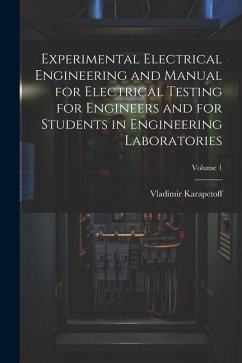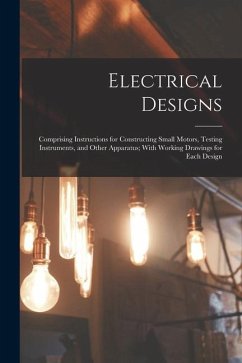
Experimental Electrical Engineering and Manual for Electrical Testing for Engineers and for Students in Engineering Laboratories

PAYBACK Punkte
12 °P sammeln!
Experimental Electrical Engineering and Manual for Electrical Testing, Volume 2, by Vladimir Karapetoff, offers a comprehensive guide to electrical engineering principles and testing methodologies as of 1911. Designed for both practicing engineers and students in engineering laboratories, this volume delves into advanced topics and experimental techniques relevant to the field. Karapetoffâ(TM)s work provides detailed instructions for conducting experiments, analyzing data, and understanding the underlying physics of electrical phenomena. This manual serves as an invaluable resource for anyone...
Experimental Electrical Engineering and Manual for Electrical Testing, Volume 2, by Vladimir Karapetoff, offers a comprehensive guide to electrical engineering principles and testing methodologies as of 1911. Designed for both practicing engineers and students in engineering laboratories, this volume delves into advanced topics and experimental techniques relevant to the field. Karapetoffâ(TM)s work provides detailed instructions for conducting experiments, analyzing data, and understanding the underlying physics of electrical phenomena. This manual serves as an invaluable resource for anyone seeking a deeper understanding of electrical engineering practices during the early 20th century, blending theoretical knowledge with practical application. This work has been selected by scholars as being culturally important, and is part of the knowledge base of civilization as we know it. This work was reproduced from the original artifact, and remains as true to the original work as possible. Therefore, you will see the original copyright references, library stamps (as most of these works have been housed in our most important libraries around the world), and other notations in the work. This work is in the public domain in the United States of America, and possibly other nations. Within the United States, you may freely copy and distribute this work, as no entity (individual or corporate) has a copyright on the body of the work. As a reproduction of a historical artifact, this work may contain missing or blurred pages, poor pictures, errant marks, etc. Scholars believe, and we concur, that this work is important enough to be preserved, reproduced, and made generally available to the public. We appreciate your support of the preservation process, and thank you for being an important part of keeping this knowledge alive and relevant.












